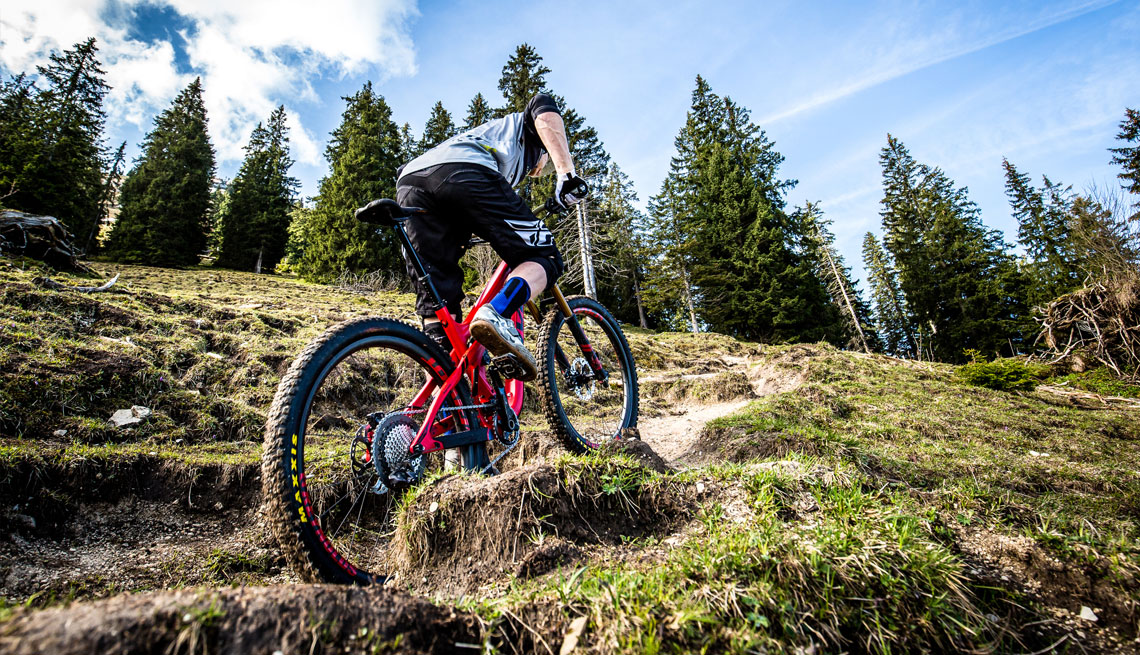
04 Aug BootDoctors: Why You Need A New Bike Now!
“The (Boot)Doctor is in the House” is a series from beloved family-owned and operated outdoor retailer BootDoctors to share the power of mountain life: adventure, style, gear, and community. Here the good guys always get to ski powder and bag summits and the sunset is always spectacular. This week, BootDoctors blogs about bikes and which wheels might be best for you.
For up-to-date-information on the best bikes in store, go here.
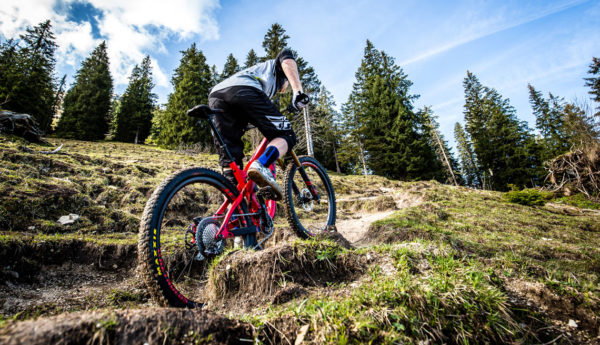
They say money can’t buy you happiness.
But, they’re wrong.
Because it can buy you a new bike and nothing will make you happier.
I know because I just bought one.
I’m the type who buys a new bike every few years. I usually get a high-end, lightly-used, carbon, cross-country bike with top of the line components. And they’ve all been great – a Santa Cruz Blur, Yeti ASR, and Giant Anthem. But they haven’t necessarily been my first choice rides – more of a convenient crossing of paths.
So this time around, I did it differently. I wanted to buy a brand new bike. One that I researched and chose intentionally. One that nobody would have ridden before me, and one that no one else will ride while I own it.
My first task was to find the type of bike I wanted – the “class.”But with all of the bikes and options on the market, where to begin can be confusing. My previous bike was a carbon race machine with a 29-inch wheel that allowed me to crush the uphill and gave me everything I wanted on a rugged cross country trail. But, I wanted to go faster on the downhill without giving up too much on the climbs.
I had definitely had fun on my old bike, but when I rode, it was usually some sort of long-haul, cross-country, suffer fest. All of my friends with “trail bikes” (aka bikes with more suspension and dropper seat posts) talked about how “fun” their bikes were. And believe me, the new choices in bikes are all about fun—enduro bikes with six inches of suspension, downhill bikes with raked forks, and fat bikes with the ultimate traction.
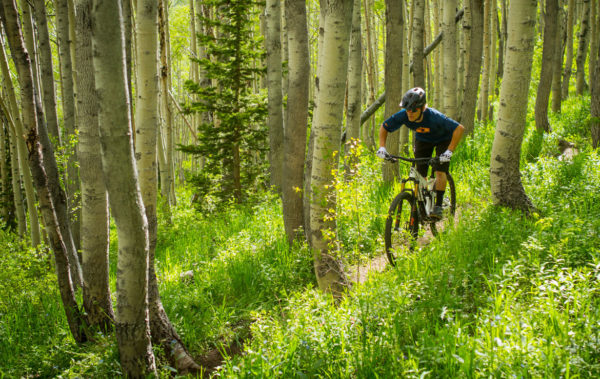
From what I’d read and heard, the bikes produced in the last year could do everything I wanted and more.
Advances in rear suspension combined with a more slacked angle of the front fork and more precise gearing (with one cassette in the front versus two) allows for more efficiency on the climbs and flow on the descents. And maybe a bike with a 27.5 wheel would be a better compromise for technical descents and hairpin turns.
I knew my class: the cross-country, end-of-the-trail bike genre. Now I had to find my brand. And from what I was choosing between, it was a win/win: Like choosing between an Audi and a BMW.
Did I want the Pivot Mach 4, or the Specialized Stumpjumper? Did I want a 27.5-inch wheel, a 29-inch wheel or the increasingly popular 27.5 plus wheel, which would allow for wider tires known in the industry as mid-fats? What was the difference between all of these choices anyway?
To find answers, I researched on my own, spent a considerable amount of time talking to the experts in the industry – like those at the BootDoctors – and demoed all of the bikes that piqued my interest. Finally, I decided on one (which I will not disclose here as not to influence your choice), laid it gingerly in the back of the car, skipping the outside rack to keep it pristinely new as long as possible, then proceeded to hammer away on a muddy Prospect Loop.
And, I must say. I have never loved a bike so much.
To find the bike of your dreams, visit the experts at the BootDoctors. You’ll leave with a smile then giggle until the snow starts falling. And go here.
What You Need to Know About Wheels:
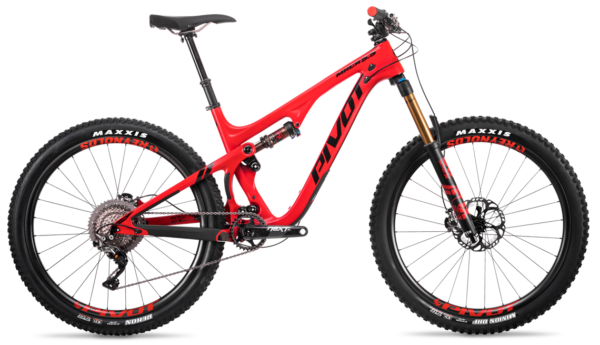
26, 27, or 29:
Back in the day, all adult bikes had 26-inch wheels; that was the industry standard. However, in the last decade, there have been changes not in only in wheel size, but also in width. First came the 29er, or bikes with 29-inch wheels—bigger wheels to give a rider more ease at rolling over obstacles and more speed on trails with a consistent grade. However, for some riders, the 29-inch wheel felt less agile and stable on technical trails that called for advanced bike handling. So next came the 27.5 (also called the 650b), which was meant to give the rider something in between the efficiency of the 29er wheel and the agility and stability of the 26-inch wheel.
Regular, Mid-Fat and Fat Tires:
In the last few years, bikes have also been trending with fatter tires. Standard tires range from 2.2 inches to 2.5 inches wide. Mid-fats are tires with a width about or 2.8 inches to 3 inches wide. This is the width for bikes referred to as 27.5 plus. And fat tires are bikes with wheels that exceed 3.8 inches in width. The very basic philosophy is that the bigger tires give more traction, however they also add weight and may affect a bike’s agility. The trick is to find the perfect balance for you.
The best way to see what is right for you is to consult with an expert like Tony Jakob at the BootDoctors, considering the type of riding you do most and the type of rider you are. Are you always in the downhill park? Or, one that hammers every hill and Stravas every ride? Or, are you a social rider that dabbles in it all? Whatever you ride, get out and try a few different bikes.
Buying a bike is like online dating, you’ve read the profiles, but won’t know what’s right for you until you take it out…..on the trail.
More about BootDoctors Ski, Snowboard & Bike Shop (from the desk of Penelope Gleason):
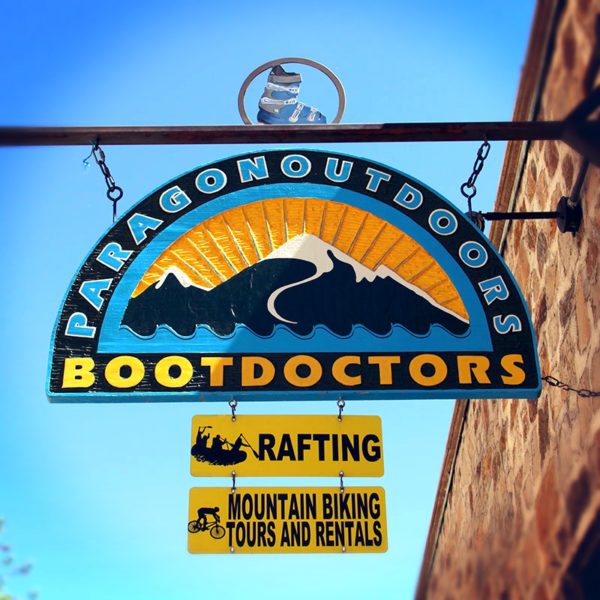
It was the winter ski season of 1985. Bob Gleason looked up from the boot-fit bench at Taos Ski Valley and caught the glances of the folks lined up out the door. Anxious faces of skiers.
“Bring us your sore, cold, numb, battered feet…and we will make them able to ski again,” thought the grinning Irishman as he labored to bend the stiff plastic of a ski boot to his bidding.
Ski boots in the eighties were only slightly better than torture devices. They had, in fact, improved substantially from the old days of leather, but hard plastics and packed-out liners more often than not tamped down a skier’s enthusiasm.
Bob Gleason had dedicated his professional life to making ski boots more comfortable and better performing.
After a stint at Hanson boots, where he addressed a number of key problems presented by skiers and many pro athletes, Bob was drawn to the emerging ski mecca of Taos Ski Valley by the famous ski pioneer Ernie Blake.
Now Bob Gleason and his partner Bob Reminger were struggling to keep up with demand for their boot-fitting skills. The need for a new ski shop with a focus on boot-fitting became glaringly obvious.
In 1986, the two Bobs started their own shop in Taos Ski Valley, with a central focus on the highest quality ski boot-fitting. They were joined by Linda Gleason and, later, by Kyle Reminger in the shop, where they added ski clothing and accessories into the mix. It was a smart business model: once skier’s boots came off, shoeless individuals were confined to the store for the better part of an hour. Why not pass the time browsing all the cool gear while waiting for your boots to be altered?
The original shop and the newer Telluride stores stand on a foundation built on the combined values of deep knowledge, quality workmanship and products, customer service, and personal passion for skiing and other mountain, trails, and river-based sports. All the folks who work at BootDoctors live in and love the outdoors and are always ready, willing, and able to share their expertise to help others have great outdoors experiences too.
The TSV BootDoctors store was at first inconveniently located, away from the Main Street traffic stream and across a river. Some devotees scrambled through the frozen river bed to reach the shop rather than hike around. That was remedied in the darkness of one night, when the landlord, JB Cottam, snuck in a new bridge, much to the surprise of the ski area owners and competitors.
The rest is history…
It is history that stretches over 30 years of world-renowned boot-fitting done on site at the highest quality ski shop, still owned and run by two families, the Gleasons and the Remigers. Many awards decorate the walls for “top boot-fitting” and “most knowledgeable staff” – many of whom have been with the business for more than 20 years.
Loyalty is the key element to survival. Loyalty has taken BootDoctors through droughts and fierce local competition, as well as competition from big sporting goods chains and the rapid growth of on-line shopping. Loyalty of the staff and loyalty of the customers, who return generation after generation, bringing children and grandchildren for gear and services.
In 1996, Bob Gleason, who had been exploring the landscape of ski area retail as he traveled teaching Master Ski Tech and Masterfit Bootfitting clinics all over North America, became enamored of the rustic town of Telluride, which was on the verge of a major revival with a new owner of the ski area. Gleason moved to Telluride and one year later decided to open a BootDoctors store in the quickly growing Mountain Village. The need for quality boot-fitting and a homegrown, old fashioned, owner-operated ski store fit his skills well.
Over 20 years in Telluride, the BootDoctors grew to encompass a large storefront in Mountain Village and take over the Paragon Sports stores, another locally owned sporting goods outfit. The expansion allowed BootDoctors’ customers to benefit from the master boot-fitting and high-quality products on both sides of the mountain.
In 1998, Penelope Gleason joined the crew as marketing director after a stint in retail and inventory control. The Gleasons’ daughters, Kelli and Galena, joined the business after college and rose to the ranks of management and top buyers.
Purchase of the Paragon stores allowed the merchandise mix to reflect another of the family’s passions: cycling. Biking had been one of Gleason’s summer recreational passions – along with river-guiding since the 1970s.
BootDoctors also grew their summer offerings in Telluride to include rafting, paddle boarding, mountain bike rentals, retail, repair, and tours. In Taos, they added a store in the downtown in collaboration with the area’s top fly fishing outfitter, Solitary Angler.
The same quality and passion found in the boot-fitting department permeates the other departments, from ski rentals to outdoor clothing, bikes and guided adventure tours.
Never known to rest on its laurels, BootDoctors became the first entity in Telluride to offer Fat Tire Bikes for rent, sale, and tours.
Quality, knowledge, passion for sport and personal service are values being carried forward by the awesome staff at all five BootDoctors stores today.
The same big grin that sparkles on the ski slope, under his bike helmet, or in the boot-fit room shines as Bob watches his daughters Kelli and Galena continue the traditions while buying hard and soft goods, managing different departments in the business, and excelling in skiing, biking, and river-running.
Bob knows the future looks good for the next generation of BootDoctors and their loyal customers.


Pingback:THE HARD TRUTH: Why You Need A New Bike NOW! | BootDoctors® Ski, Snowboard & Bike Shop
Posted at 09:14h, 08 August[…] Read Jesse’s in-depth reasoning & buying process adventure on her new bike purchase on TELLURIDE INSIDE & OUT. […]